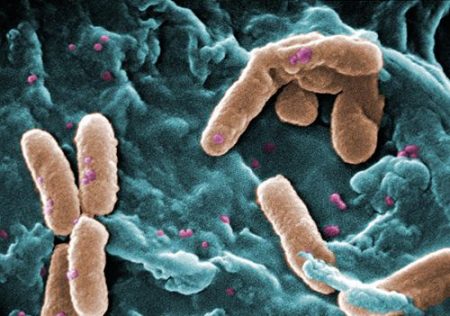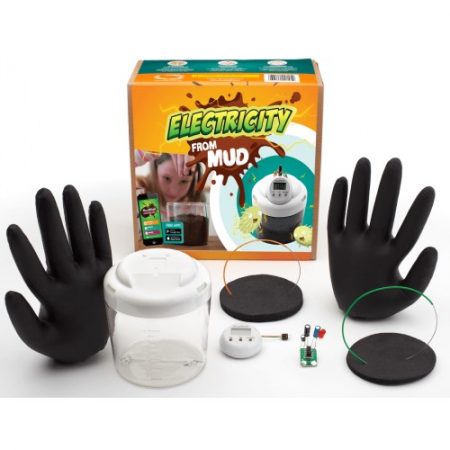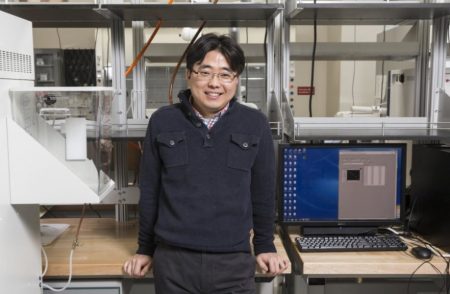March 27, 2017 – For $39.99 U.S. you can try this technology yourself, purchasing the MudWatt (TM) Microbial Fuel Cell Kit. Meant to be a classroom learning tool, this kit (seen in the image below) includes a container, a graphite anode, and cathode, LED blinker light combined with a clock circuit, a pair of Nitrile Gloves, and instruction booklet with explorer app that runs on a smartphone.
Just fill the container with soil from the garden and you have your energy source. The microbial population interacting with soil chemistry will multiply, respiring and expelling electrons in the process. The electrons migrate to the two graphite electrodes completing the circuit. The LED display will blink faster and faster as the electrical current builds from the microbes just doing what they do, feeding and replicating. If the current begins to die, to refuel just look for something old and organic in your refrigerator and toss it into the container. Voila, the current will start up again.
Drawing energy from soil is not a new concept. An Earth Battery was first demonstrated in 1841 by Alexander Bain using two pieces of metal as electrodes, one copper, the other zinc. He placed them about one meter (3 feet, 3 inches) apart and buried them in the ground. He then connected a wire circuit producing total power output of one volt.
Soil on its own works as an electron generator best when wet and biologically active. Otherwise, it quickly runs out of electrolyte. Bacteria, however, are key because through metabolizing what’s in the soil, they produce the free electrons that generate a current.
What kind of bacteria is best? Nothing special. Just the common variety types found in garden soil including varieties of Shewanella, Rhodoferax, and Geobacter. Theoretically, if you make the soil volume big enough, and keep feeding the bacteria with waste organic matter you can generate enough power to recharge a cellphone or other small digital device.

Microbial fuel cells or MFCs are just a slight upgrade from Bain’s 1841 experiment. As bioreactors, they can become a renewable energy source. Their high conversion efficiency of 90% of the electrons produced by the biochemical interaction between bacteria and the surrounding soil makes them a likely energy producing candidate in a number of industry niches including:
- Generating energy from wastewater treatment plants with the added benefit, the microbes clean the water of organic solids reducing pollutants.
- Replacing batteries to power remote sensors and devices that can draw energy from soil bacteria.
- Powering underwater monitoring devices in creeks, rivers, and oceans fuelled by bacteria found in bottom sediments.
- Harvesting hydrogen for fuel, a byproduct of the microbial biochemical reaction.
So why isn’t this technology in play everywhere?
As promising as it appears as a source of renewable energy, the challenge of soil batteries and MFCs has always been scale. You need a lot of soil and microbial volume to generate power sufficient to run all the technology within a modern home.
Most recently researchers at Binghamton University created an MFC that continuously generated power for 13 straight days through the symbiotic interaction of two bacteria types, one heterotrophic and the other photosynthetic. Their cell chamber was about one-fifth the size of a teaspoon (approximately 90 microliters). The heterotrophic bacteria fed off the organic matter while the photosynthetic bacteria used sunlight and carbon dioxide (CO2). A dose of organic matter was fed to the mix of bacteria and over 13 straight days, through their metabolic processes, the microbes produced 8 microamps per square centimeter. States Seokheun Choi, (seen in the picture below) Assistant Professor, Electrical and Computer Science at Binghamton, “heterotrophic bacteria-based fuel cells generate higher power, while photosynthetic microbial fuel cells provide self-sustainability. This is the best of both worlds.” To run a large flatscreen television, you would need to scale up the MFC that Choi and his colleague, Lin Liu built by 62,500 times (a fuel cell about 12,500 teaspoons in size).
The Binghamton University research has been published in the March issue of the Journal of Power Sources.

















